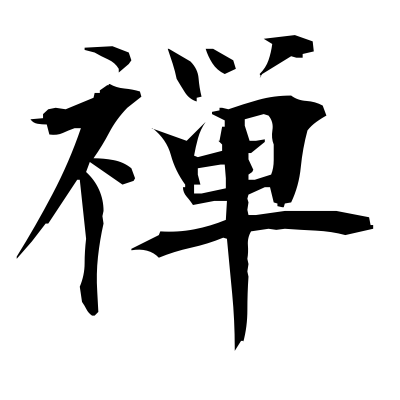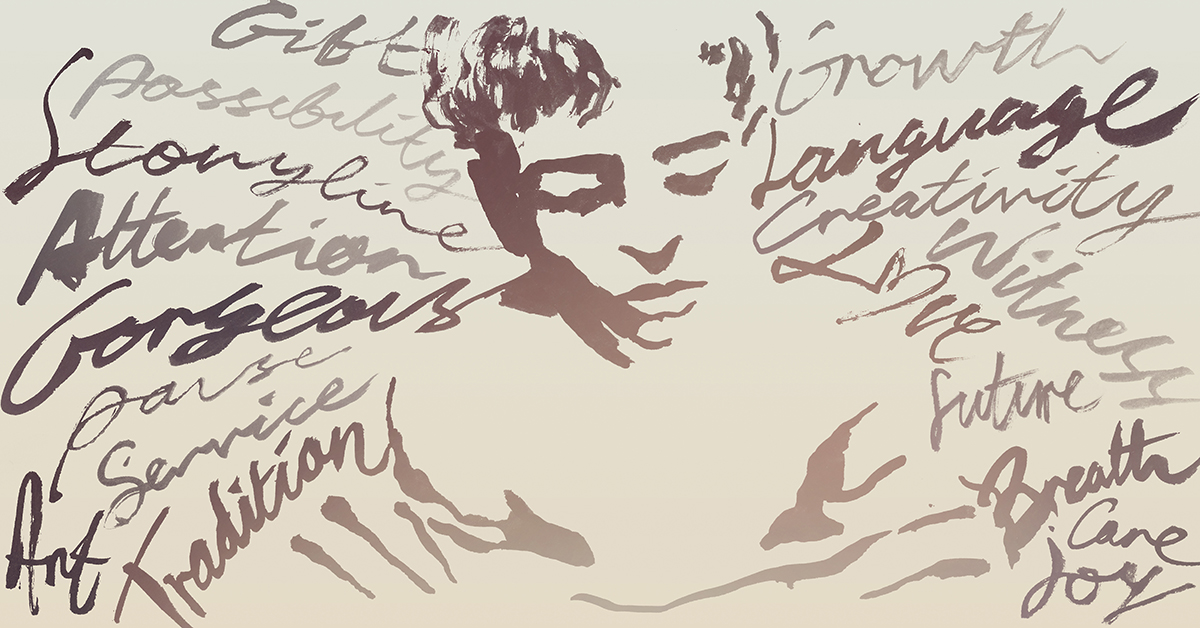“As I started to become a writer and developed my Zen Buddhist practice, I saw that fear is ultimately energy. And as an artist, you ask yourself, ‘What do I do with this energy?’” – Ocean Vuong

What is Zen Buddhism?
Zen Buddhism is a hard term to define because, as it has become more popular and spread throughout the world, the practices customs and beliefs of this sect of Buddhism have transformed and evolved. Even as this is true, the core of Zen is that it is a sect of Mayahana Buddhism originating in China, even as it’s ideas were imported from India. Although it is commonly agreed that this religion originated in China, the term “Zen” refers to the Japanese pronunciation of the Chinese word “Chan” as both use the same character.

Japanese “Zen”

Both “Zen” and “Chan” respectively are translations of the Sanskrit term “Dhyana” which essentially translates to ‘meditation.’
One source, admitting that Zen was two baggy and untidy to easily define, gave a list of differing Zen quotes in order to provide some of the essence of Zen.
- The essence of Zen Buddhism is achieving enlightenment by seeing one’s original mind (or original nature) directly; without the intervention of the intellect.
- Zen is big on intuitive understanding, on just ‘getting it’, and not so hot on philosophising.
- Zen is concerned with what actually is rather than what we think or feel about what is.
- Zen is concerned with things as they are, without trying to interpret them.
- Zen points to something before thinking, before all your ideas.
- The key to Buddhahood in Zen is simply self-knowledge.
- To be a human being is to be a Buddha. Buddha nature is just another name for human nature – true human nature.
- Zen is simply to be completely alive.
- Zen is short for Zen Buddhism. It is sometimes called a religion and sometimes called a philosophy. Choose whichever term you prefer; it simply doesn’t matter.
- Zen is not a philosophy or a religion.
- Zen tries to free the mind from the slavery of words and the constriction of logic.
- Zen in its essence is the art of seeing into the nature of one’s own being, and it points the way from bondage to freedom.
- Zen is meditation
The important thing to note is that Zen is not a single contained set of values, but an idea that transforms and morphs to fit the circumstances of each practicer.
Origins of Zen Buddhism
Even as the philosophies’ of Zen originated from India, and the term “Zen” is referencing the Japanese term for this practice, most scholars state that Buddhism originated in China during the Tang Dynasty (618-907). Early documentation of Zen can be found in the writings from the 5th century but became more popularized in the 8th century. It was when the Empress Wuhou (625-705) overthrew the ruling Tang Dynasty leaders and created the brief 15 year Zhou Dynasty (690-705) and implemented Zen Buddhism into her short but powerful reign.
Painting of the Empress Wuhou
After her death, and the return to the Tang Dynasty, sectarian schisms occurred as orthodox Zen Buddhists who aided the Empress were castigated by another faction who claimed to be a more legitimate form. This rivalry eventually led to an inclusive form of Zen Buddhism in the Song dynasty (960-1279) that spread to Korea, Japan and Vietnam. Already in this early form of Zen do we see it’s transformation due to a variety of circumstances, causing people to reshape the philosophy to fit their needs.

Modern Zen
A Japanese Buddhist scholar and thinker named D.T. Suzuki (1870-1966) introduced many western thinkers to this philosophy. As a thinker living in the Meiji Period when western technologies and philosophies were being imported into Japan, Suzuki was hoping to conversely create a modern form of Asian philosophy that could compete with Christianity.

D.T. Suzuki helps spread ideas of Zen Buddhism from Japan to the West
Note: Although the basic narrative is that Zen Buddhism was introduced to The West specifically from Japan, many forms of Zen Buddhism came to America and Europe from many various countries in Asia including Vietnam, Korea and China.
Suzuki’s version of Zen was transformed by his contemporary Western intellectuals, transforming the practice once again. Suzuki’s view of spiritual awakening was that those moments of “Enlightenment” were when they were able to transcend every day, logical and non dualistic thought into a place of pure experience unattainable by logical means.
His ideas and books became popular in America after World War II in America and Britain when Western intellectuals became interested in Eastern philosophies. These philosophies helped influence American literary movements such as the Beat movement in the 1950s and 1960s. Such notable writers who used, and perhaps misused, Zen Buddhism ideas were Alan Ginsburg and Jack Keruoac.

Zen Buddhism and Ocean Vuong
Because Zen Buddhism is hard to define as it keeps mutating and evolving, Ocean Vuong’s version of Zen Buddhism is distinctly his own. As a man of Vietnamese Queer identity who grew up in Connecticut, Vuong has an inevitably unique perspective on the philosophy as he grew up with these conflicting backgrounds: there’s a Vietnamese version of Buddhism, there’s a more Westernized version of Buddhism, and some versions of Zen Buddhism in its early years regarded homosecuxality as a form of misconduct while others did not. Vuong, embracing his own fractured identity makes his own version of Zen Buddhism that is seen in his art.

Vuong’s version of Buddhism focuses on the channeling of energy for moral purposes that is responding to his life growing up in Hartford. This Zen influence can be found in many of his works, especially in On Earth We’re Briefly Gorgeous.
“Cocaine, laced with oxycodone, makes everything fast and still at once, like when you’re on the train and, gazing across the fogged New England fields, at the brick Colt factory where cousin Victor works, you see its blackened smokestack— parallel to the train, like it’s following you, like where you’re from won’t let you off the hook. Too much joy, I swear, is lost in our desperation to keep it” (Vuong, 187).
According to Vuong in his acknowledgement’s section, the final sentence of this paragraph is based off of the idea of “Joy and Impermanence” that was echoed by the poet Max Ritvo in a 2016 interview on Divedapper.com. This is one instance of an Americanized form of Buddhism ineracting with Vuong’s Vietnamese/Connecticut backround, highlighting how the specific circumstances of Vuong’s life shape both his writing, and his forumaltion of this practice to fit his own circumstances.

This idea of “Joy and Impermanence” interacts with Vuong’s concerns about drug distribution and drug use that is still prevalent in Connecticut today. To Vuong, Zen Buddhist practices can be a way of evolving away from a destrctive lifestyle and be a gateway for one that is more healthy and moral. In turn, his art’s value comes from this same healing and moral purpose as well.
Vuong goes into more detail of his Zen practice in this video.
Although he does not explicitly mention Zen within On Earth We’re Briefly Gorgeous, it is clear that he channels this energy within it, allowing its healing and moral essence to be felt palpably by readers worldwide.
Within Connecticut there are many different places of worship for Zen practicers. These places can be seen to have differering origins and practicies, stemming from the different cultures they came from.
Buddhist Faith Fellowship of Connecticut
White Lotus Haven Zen of Connecticut
Chenrezig Tibetan Buddhist Center
International Buddhist Zen Inc
Odiyana Kadampa Buddhist Center
Hartford Karma Thegsum Choling
Sources
“History of Zen Buddhism” Association Zen Internationale
“Zen: History, Doctrines, Practices and Facts” Britannica
“Japanese Zen Buddhism Philosophy” Stanford Encyclopedia of Philosophy
“Zen Buddhism” BBC
“Beat Buddhism and American Freedom” Kyle Garton-Gundling
On Earth We’re Briefly Gorgeous Ocean Vuong
“What Scares Writer and Zen Buddhist Ocean Vuong” Raisa Tolchinsky